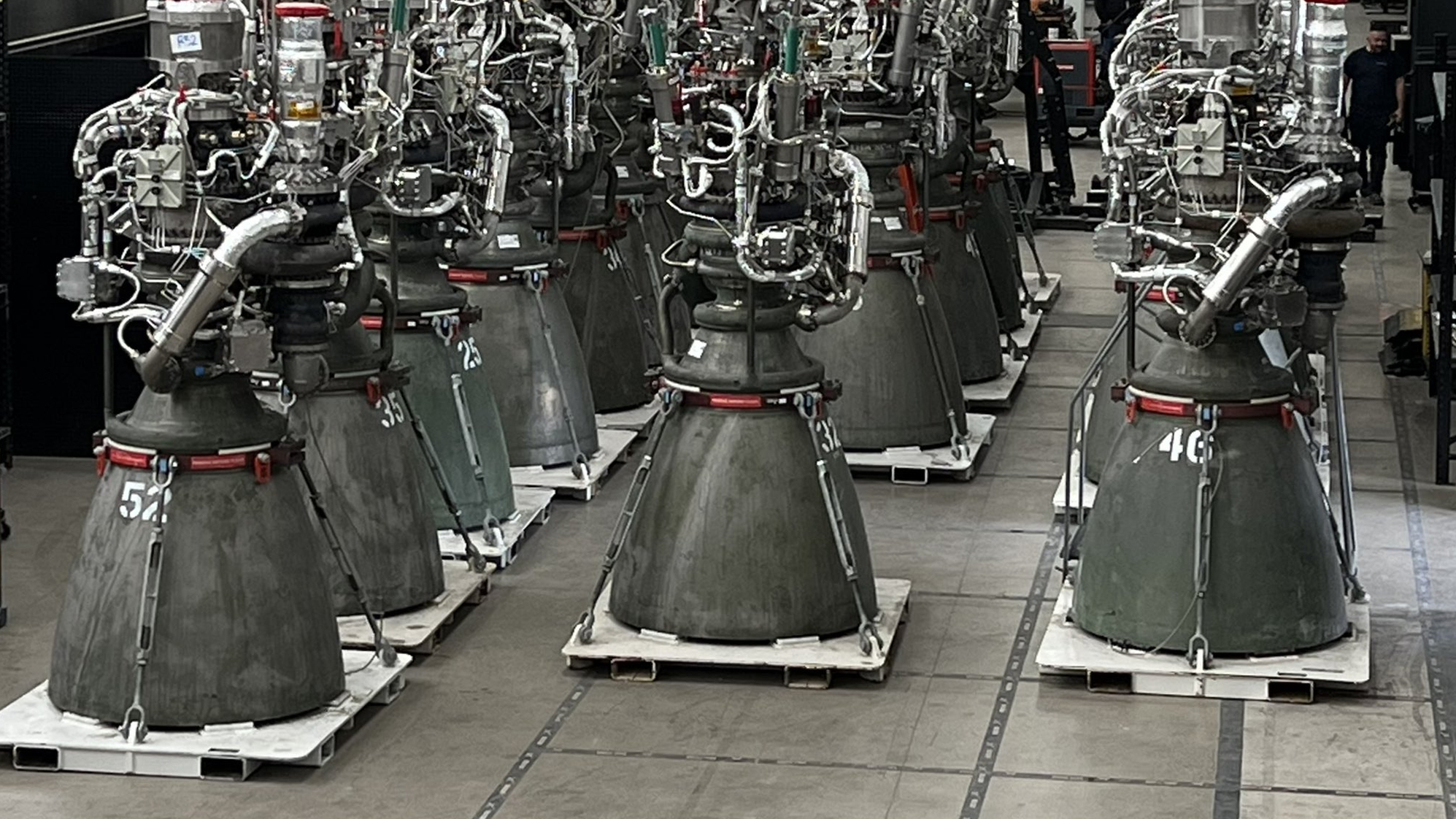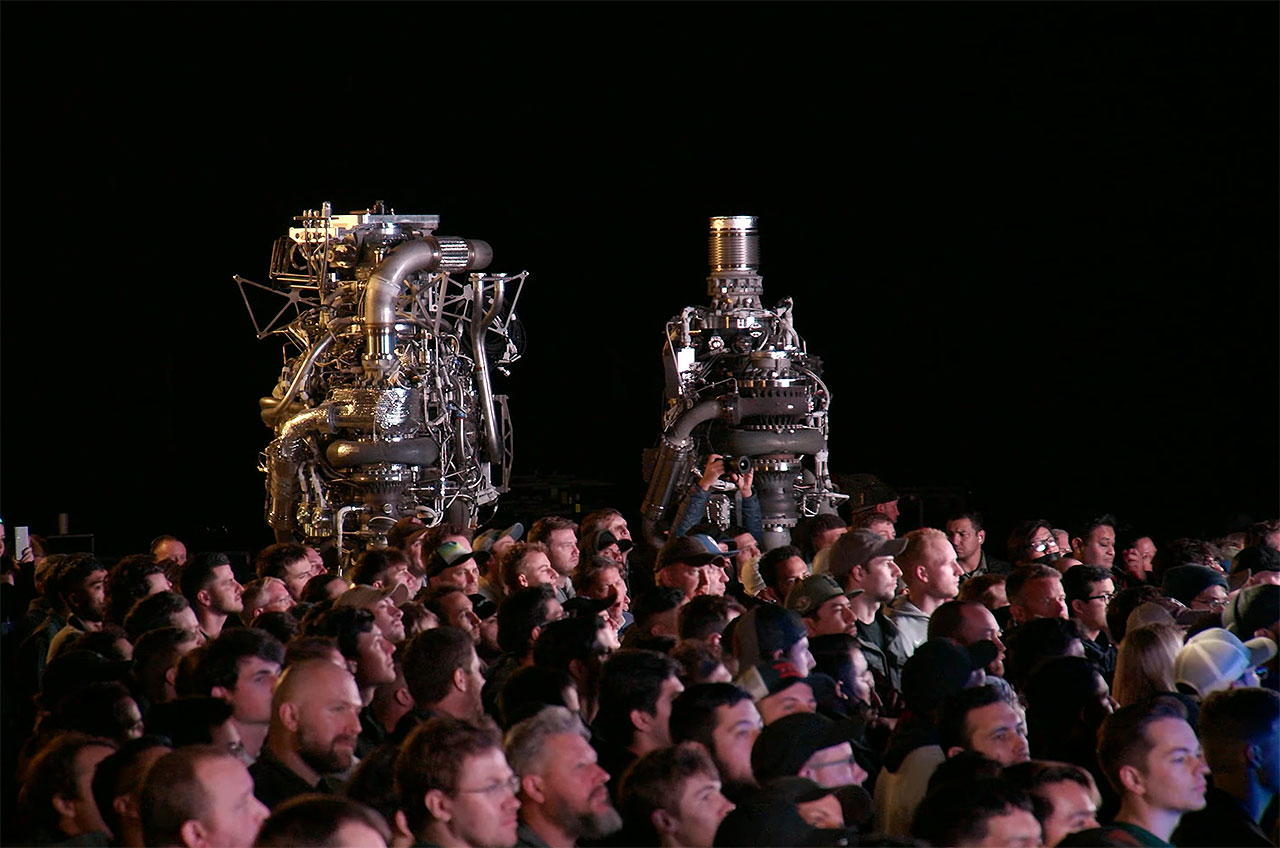Elon Musk shows off new SpaceX rocket engines for Starship. Twitter fans see Daleks.
No, they don't have plungers and scream "Exterminate!" Yes, they will fly in space.

Elon Musk seems pretty proud of his company SpaceX's new rocket engines.
This week, Musk showed off a batch of the new Raptor 2 engines at the SpaceX's Starbase facility in Texas, where they will be used on the first orbital flight of the company's Starship megarocket later this year.
"Raptor 2 rocket engines at Starbase, each producing over half a million pounds (230 tons) of force," Musk wrote in the Twitter post on Tuesday (April 26). Musk's photo showed what appeared to be over a dozen of the new rocket engines, but his Twitter fans saw something else: evil Daleks from Doctor Who.
Raptor 2 rocket engines at Starbase, each producing over half a million pounds (230 tons) of force pic.twitter.com/9ixxXXceG3April 26, 2022
"It was only a matter of time before he started building Daleks," wrote Twitter user Richard Nellis as the term "Daleks" began trending after Musk's photo post.
"Turns out Elon has created Daleks. Elon IS Davros," wrote Simon, another Twitter user, referring to the creator of the Dalek warriors, who reside inside machines do bear some resemblance to a rocket engine nozzle.
It was only a matter of time before he started building Daleks. pic.twitter.com/YsefAt6DgLApril 26, 2022
Turns out Elon has created Daleks. Elon IS Davros. https://t.co/IwA6ID4wshApril 26, 2022
New daleks just dropped https://t.co/GGV7gY3lecApril 26, 2022
Here's a look at Doctor Who's Daleks. Do you think SpaceX's Raptor 2 engines are similar?
At first i thought these where a bunch of daleks pic.twitter.com/zuRzlwYC4lApril 26, 2022
To be clear, Elon Musk has not created a race of evil warriors that cry "Exterminate!" as they take over the world. The Raptor 2 will be the workhorse engine for SpaceX's Starship rockets and their massive Super Heavy boosters.
Get the Space.com Newsletter
Breaking space news, the latest updates on rocket launches, skywatching events and more!
Each Super Heavy booster will be powered by 33 Raptor 2 engines while the Starship vehicle will use nine Raptor 2 engines of its own. Like SpaceX's veteran Merlin engines on its Falcon 9 rockets, the Raptor 2 is designed to be reusable, as are the Starship and Super Heavy vehicles.

The Raptor 2 is fueled by liquid methane and liquid oxygen, which is a new fuel for SpaceX. It's Falcon 9 rockets use liquid oxygen and rocket-grade kerosene in their Merlin engines.
SpaceX has been developing its Raptor engines for several years, with Raptor 2 as the result. It has a more streamlined design over SpaceX's first version of the Raptor, including less complicated tubing and plumbing lines.
"The V1 kind of looks like a Christmas tree spaghetti pile — a lot of 'fibbly' bits. V2 is greatly simplified while also increasing thrust at the same time," Musk said in a Feb. 10 Starship update.
It may be SpaceX's work to streamline the Raptor 2 that gave it a more Dalek-like resemblance for Doctor Who fans this week. Still, some fans of the sci-fi show were surprised Musk hadn't targeted a different Who villain to emulate.
I always thought Elon Musk would create Cybermen before he created Daleks. pic.twitter.com/rGGFYoflsqApril 26, 2022
"I always thought Elon Musk would create Cybermen before he created Daleks," wrote Geekgirlforever.
Email Tariq Malik at tmalik@space.com or follow him @tariqjmalik. Follow us @Spacedotcom, Facebook and Instagram.
Join our Space Forums to keep talking space on the latest missions, night sky and more! And if you have a news tip, correction or comment, let us know at: community@space.com.

Tariq is the Editor-in-Chief of Space.com and joined the team in 2001, first as an intern and staff writer, and later as an editor. He covers human spaceflight, exploration and space science, as well as skywatching and entertainment. He became Space.com's Managing Editor in 2009 and Editor-in-Chief in 2019. Before joining Space.com, Tariq was a staff reporter for The Los Angeles Times covering education and city beats in La Habra, Fullerton and Huntington Beach. In October 2022, Tariq received the Harry Kolcum Award for excellence in space reporting from the National Space Club Florida Committee. He is also an Eagle Scout (yes, he has the Space Exploration merit badge) and went to Space Camp four times as a kid and a fifth time as an adult. He has journalism degrees from the University of Southern California and New York University. You can find Tariq at Space.com and as the co-host to the This Week In Space podcast with space historian Rod Pyle on the TWiT network. To see his latest project, you can follow Tariq on Twitter @tariqjmalik.









